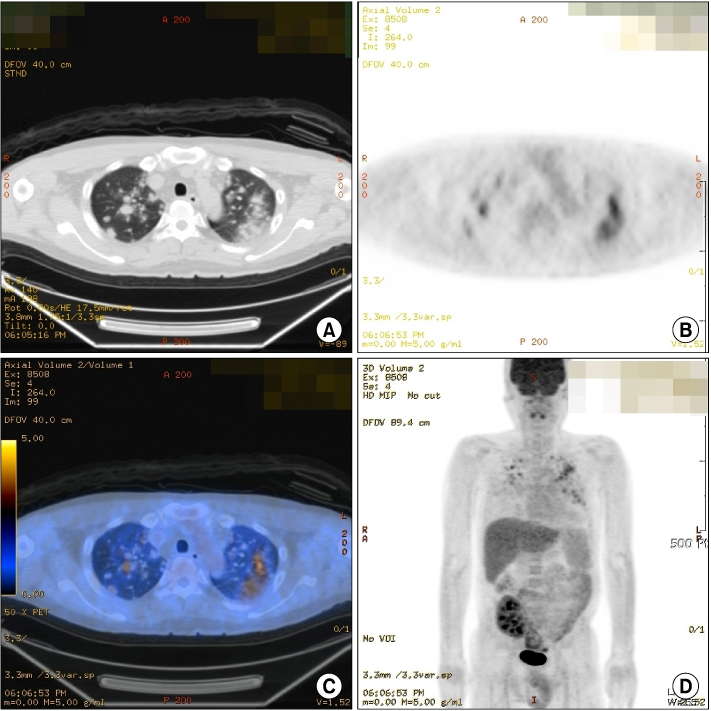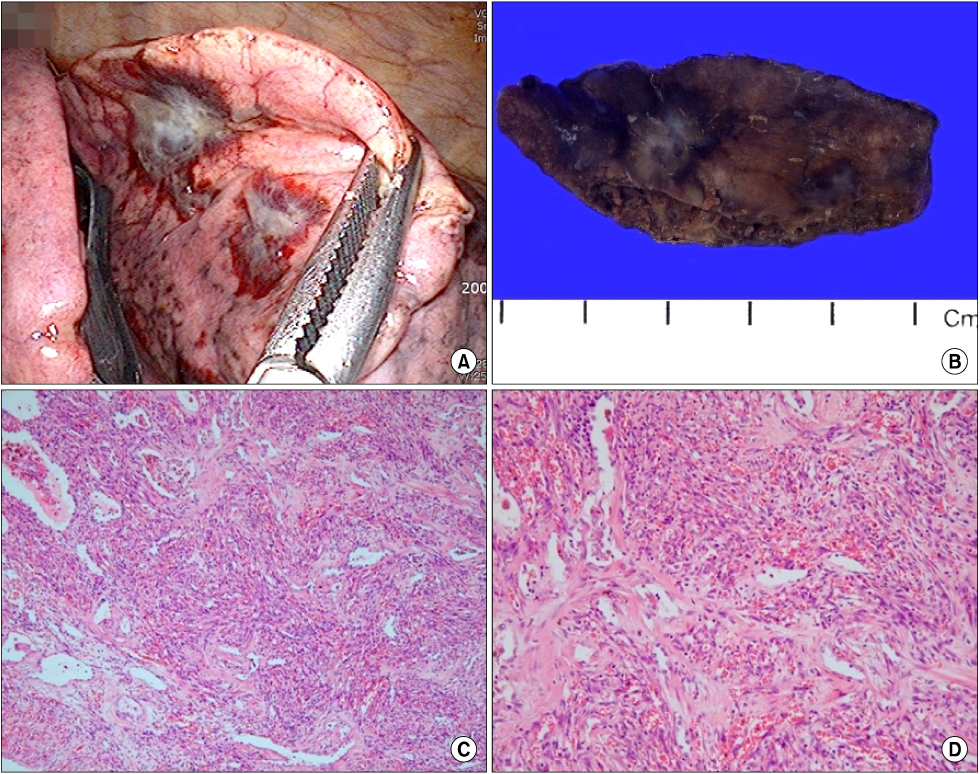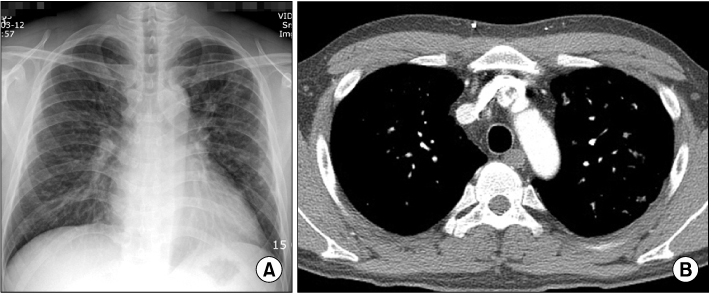J Korean Soc Transplant.
2012 Dec;26(4):299-304. 10.4285/jkstn.2012.26.4.299.
Successful Sirolimus Treatment of Kaposi's Sarcoma in Multiple Pulmonary Nodules after Kidney Transplantation
- Affiliations
-
- 1Department of Pulmonary and Critical Care Medicine, Ajou University School of Medicine, Suwon, Korea. sssheen@ajou.ac.kr
- 2Department of Surgery, Ajou University School of Medicine, Suwon, Korea.
- KMID: 2202434
- DOI: http://doi.org/10.4285/jkstn.2012.26.4.299
Abstract
- Kaposi's sarcoma is one of the most serious complications associated with immune suppression treatment after kidney transplantation. Because it usually manifestations as skin lesions or lymphadenopathies, its clinical suspicion and tissue diagnosis is relatively easy. However, Kaposi's sarcoma presented as multiple pulmonary nodules without skin manifestations is not easily detected early and usually has a deadly prognosis. We present the case of a 36-year-old male who underwent kidney transplantation 13 months ago and has been on tacrolimus and mycophenolate mofetil (MMF)-based immune suppression presented dry cough, blood tinged sputum, and multiple pulmonary nodules without any skin lesions. Both bronchoscopic washing cytology and fine needle aspiration cytology of peripheral lung tissues were performed but failed due to low cellular yields. A video-assisted thoracoscopic biopsy subsequently revealed Kaposi's sarcoma. Following the diagnosis, we changed the immune suppression from a tacrolimus and MMF-based regimen to a sirolimus-based regimen. Respiratory symptoms gradually disappeared and we found complete remission on follow-up radiologic evaluations. Thus sirolimus may be the preferred method of treatment for patients with immune suppression after kidney transplantation.
Keyword
MeSH Terms
Figure
Reference
-
1. Ro H, Kim SM, Kim KW, Hwang YH, Yang JS, Oh KH, et al. Malignancy after kidney transplantation. J Korean Soc Transplant. 2006. 20:187–192.2. Kim JY, Lee J, Lee SE, Kim SH, Choi BS, Moon IS, et al. The type and incidence of malignancy in 1500 renal transplant recipients at Kangnam St. Mary's Hospital. Korean J Med. 2007. 73:67–75.3. Kim HS, Seo YM, Park UJ, Kim HT, Cho WH, Hwang EA, et al. Crude incidence rate of malignancy after kidney transplantation. J Korean Soc Transplant. 2010. 24:182–186.
Article4. Kong JM. Malignancy in renal transplant recipients. J Korean Soc Transplant. 2009. 23:130–134.
Article5. Lee DH, Bae HJ, Kang YK, Bang YJ, Han JS, Kim S, et al. Kaposi's sarcoma in renal transplant recipient. Korean J Intern Med. 1988. 34:102–109.6. Koh JK, Jung ES, Lee YS, Kang SJ, Kim BK, Kim SM. Multiple Kaposi's sarcoma in the renal transplant patient: a case report. Korean J Pathol. 1999. 33:1097–1101.7. Kim JS, Huh KH, Chun EY, Kim SH, Lee MG, Jeon KO, et al. Kaposi's sarcoma after renal transplantation. J Korean Soc Transplant. 2003. 17:166–170.8. Park HS, Kim HH, Choi YJ, Kim YO, Shin KS. A case of pulmonary Kaposi's sarcoma in a patient with renal. J Korean Radiol Soc. 1998. 38:473–476.
Article9. Sung GI, Kim YT, Sung SW, Kim JH. Intrathoracic Kaposi's sarcoma in renal transplant recipient proven by open lung biospsy: a case report. Korean J Thorac Cardiovasc Surg. 2000. 33:338–341.10. Kim WJ, Huh WS, Kim JY, Heo DS, Kim YW, Han JS, et al. A case of Kaposi's sarcoma with pulmonary nodules without skin manifestation in renal transplant patient. Korean J Med. 1998. 54:558–562.11. Marchiò S, Primo L, Pagano M, Palestro G, Albini A, Veikkola T, et al. Vascular endothelial growth factor-C stimulates the migration and proliferation of Kaposi's sarcoma cells. J Biol Chem. 1999. 274:27617–27622.
Article12. Gill PS, Akil B, Colletti P, Rarick M, Loureiro C, Bernstein-Singer M, et al. Pulmonary Kaposi's sarcoma: clinical findings and results of therapy. Am J Med. 1989. 87:57–61.
Article13. Sloand E, Kumar PN, Pierce PF. Chemotherapy for patients with pulmonary Kaposi's sarcoma: benefit of filgrastim (G-CSF) in supporting dose administration. South Med J. 1993. 86:1219–1224.14. Lee SM, Park SY, Kim SJ, Song YS, Song HH, Lee S, et al. A case of Kaposi's sarcoma improved by sirolimus treatment in the kidney transplant recipient. Korean J Nephrol. 2009. 28:82–87.15. Stallone G, Schena A, Infante B, Di Paolo S, Loverre A, Maggio G, et al. Sirolimus for Kaposi's sarcoma in renal-transplant recipients. N Engl J Med. 2005. 352:1317–1323.
Article16. Campistol JM, Schena FP. Kaposi's sarcoma in renal transplant recipients: the impact of proliferation signal inhibitors. Nephrol Dial Transplant. 2007. 22:Suppl 1. i17–i22.17. Descoeudres B, Giannini O, Graf T, Steiger J, Mayr M. No effect of sirolimus for kaposi sarcoma in a renal transplant recipient. Transplantation. 2006. 81:1472–1474.
Article
- Full Text Links
- Actions
-
Cited
- CITED
-
- Close
- Share
- Similar articles
-
- Successful Sirolimus Treatment of Multiple Visceral Kaposi's Sarcoma in a Renal Allograft Patient
- A Case of Kaposi's Sarcoma Improved by Sirolimus Treatment in the Kidney Transplant Recipient
- Kaposi's sarcoma of the oral cavity in renal transplanted patient; a case report
- A Case of Recurrent Kaposi's Sarcoma after Cyclosporine Treatment in Kidney Transplantation Patient
- A Case of Kaposi's sarcoma with Pulmonary nodules without Skin Manifestation in Renal Transplant patient






